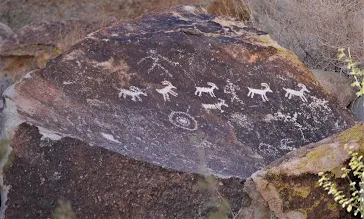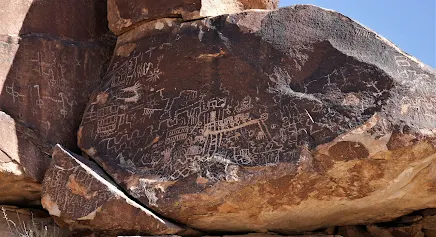.JPG) |
| Original Blacksmith shop in Daggett, Ca |
According to Mark Staggs, President of the Daggett Community Service District, the small town of Daggett has big plans.
“We have big plans,” Staggs stated.
I have always had a soft spot for this little berg, ten miles east of Barstow on Interstate 40. I used the town of Daggett for one of my novels, Operation Scorpion. I spent some time there, doing research for the fictional piece, and met some really nice folks.
But, since the publication, I haven’t been back. Sure, I drive by quite often, on my way to here and there along the interstate, but I rarely stop.
So, when I heard Staggs was giving a historical tour of the town, I knew it was time to revisit and learn more about the history of the town.
Staggs is a nice guy – truly nice. He immediately made our little group of tourists feel right at home. He is one of those fellas who likes to tell a joke, while being serious about the history of the town he truly loves.
“The history of Daggett isn’t known by a lot of tourists, but we are in the works to change that,” he shared.
Those are the big plans Staggs had mentioned earlier while conducting a fascinating tour of the Daggett Museum.
.JPG) |
| Old downtown of Daggett |
According to the Daggett Historical Society, the town was founded in the 1860s, but did not become known as Daggett until 1883. At this time, the mines were running full steam in the nearby Calico Hills. The residents realized having the mining town of Calico near Calico Junction may be a bit confusing – so, the folks decided that the name Daggett may fit the bill, using the last name of then Lieutenant Governor of California, John Daggett.
It is rumored, and don’t we all love rumors, that the Lieutenant Governor had visited Daggett at some time.
Well, here’s something of note about Daggett which isn’t a rumor. Helen Muir, the daughter of the famous naturalist, John Muir, resided in Daggett. She was instrumental in assisting her father with his writings and correspondence, but being in poor health, the family moved her from northern California to the warmer climate of Daggett.
Other visitors to Daggett during its heyday included Walter E. Scott – better known as Death Valley Scotty, Francis Marion Smith – better known as the Borax King, Tom Mix – better known as Silver Screen Cowboy, and Wyatt Earp – better known as ‘I get around the West a lot.’
There is a lot of history in this town.
.JPG) |
| One of the original water towers |
After the museum tour, Staggs offered a hands-on tour of the area.
Actually, it wasn’t exactly hands-on, but more of a drive-by and get out of your vehicle sort of visit to the numerous historical sites in and around Daggett.
According to Staggs, there were quite a few indigenous peoples who had lived in the area, long before the settlers arrived looking for rich minerals or good lands for farming and grazing.
“People have been living here for thousands of years,” he stated. “In fact, the Vanyume, or Desert Serrano were some of the Native Americans first encountered by the Catholic missionaries in the late eighteenth century.”
As to point this out, Staggs had us drive approximately a mile or so to the north of Daggett, where, behind a tall chain link fence, was a huge pile of dark colored rock. Upon those rocks were dozens of petroglyphs.
“I know they’re at least older than nineteen-forty-seven,” I replied. “Some local carved his name and date on one of the rocks.”
Staggs nodded. “And, thus the reason for the fencing.”
The town of Daggett kept growing as more and more silver was being mined out of the ground in Calico. The ore was shipped to Daggett, where it awaited a mill with ten heavy stamps, ready to start breaking up the ore and releasing the precious metals.
In fact, there was so much ore being ground up in Daggett that property values started rapidly increasing. So, when the Atchison, Topeka and Santa Fe (ATSF) railway were contemplating a location to build a heavy rail yard, the company decided on a small place named Barstow, since the land in Daggett was too expensive.
Daggett continued to prosper and became a populated and happening town. At its peak in the late 1890s, it had three stores, two restaurants, three saloons, three hotels, a lumberyard, and many other establishments which would interest miners, visitors and locals.
I followed Staggs to where remains of the Columbia stamp mill can still be seen. A large structure, nestled next to a hill, and when looking northeast, the viewer can easily see the ghost town of Calico.
“They used wagons pulled by mules to bring the ore from Calico to here for crushing,” Staggs explained.
.JPG) |
| Original wagon used in the early days in Daggett |
It could take sometimes two days to reach Daggett for milling, depending the amount of ore being towed in the wagons behind the mules. That's a long time for a mere seven miles.
“Let’s speed up, Roger,” one drover may have been heard yelling at his partner on another ore wagon.
“We’re going as fast as we can,” Roger may have replied. “Ole, Bessy is moseying at her top speed.”
As it usually occurs with mining camps, the silver or gold ore eventually runs out. This was the case for Calico – once a rich and rowdy mining camp, it soon turned into a deserted dwelling. And in the late 1890s, the population of Calico dwindled until it became a ghost town.
But one of the by-products which was found while mining in Calico was the substance, Borax.
Turns out, Borax had many uses which made being human even more enjoyable. It can be used in toothpaste and as a laundry additive. It can be used for acne cure, skin creams, and lotions. It can be used for paints and ceramic glaze. But, most importantly, it can be used for making slime for kids.
This product was a wonder find.
So, in 1891, Francis Marion Smith – the Borax King - moved to Daggett from Death Valley and installed mining operations at the Borate mine, a few miles east of Calico. It was such a successful venture that in 1898, the Borate and Daggett Railroad was built to move the Borax to Daggett, which was easier and cheaper than the twenty mule team wagons which were being used.
Unfortunately, in 1911, richer Borax finds were located back in Death Valley, and the Borax King left.
The population and economy of Daggett soon decreased through the years, to its present day figure of two hundred citizens.
Lawrence Vintus, a member of the Daggett Historical Society and employee of the Community Services District, believes there is a rebound coming for the town in which he was born and raised.
This is a pretty ambitious belief for a young man who graduated high school in 2020. His love of Daggett is evident in every word he uses when discussing his hometown.
“We’re going to make this town a tourist destination,” Vintus announced, while showing the tour group around Alf’s blacksmith shop, built in the late 1800s. His family has owned the property, where the shop is located, for decades – a lot of decades.
.JPG) |
| Some of the treasures inside the blacksmith shop |
As I walked through the tall dusty wooden doors into the interior of the blacksmith shop, I felt as if I had just walked back in time. Tools, from the late 1890s were lined up everywhere around the shop. It was though the blacksmith had just left for an afternoon break.
“This is how my grandfather left it for us,” Vintus said. “Now we want to share it with everyone.”
Staggs nodded. “Mugwumps is being renovated as a visitor’s center, with a restaurant, gift shop, and a place tourists can visit to understand the importance Daggett.”
Standing there, in the blacksmith’s shop, looking at these two men, it was hard to imagine they would fail at their dream of making Daggett a must go place to see.
When I wrote my novel, I used Daggett as a place for the protagonist. There was a reason he had to go there. There was a reason I had to write about it. And, now it is a place for all with a love of history should venture to.
.JPG)
.JPG)









